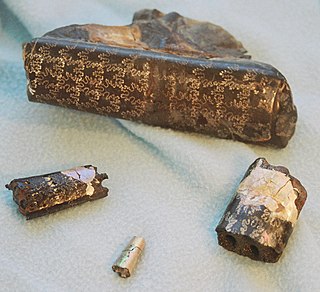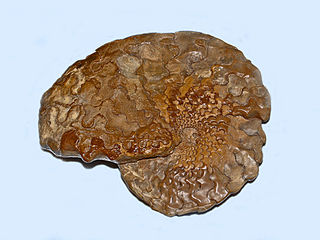
Goniatids, informally goniatites, are ammonoid cephalopods that form the order Goniatitida, derived from the more primitive Agoniatitida during the Middle Devonian some 390 million years ago. Goniatites (goniatitids) survived the Late Devonian extinction to flourish during the Carboniferous and Permian only to become extinct at the end of the Permian some 139 million years later.

Baculites is an extinct genus of heteromorph ammonite cephalopods with almost straight shells. The genus, which lived worldwide throughout most of the Late Cretaceous, and which briefly survived the K-Pg mass extinction event, was named by Lamarck in 1799.
Beudanticeras is an extinct cephalopod genus from the Late Cretaceous period; Albian and Cenomanian, belonging to the ammonoid subclass and included in the family Desmoceratidae.
Ussuria is a genus of Lower Triassic ammonites with a smooth, involute discoidal shell with submonophyllic sutures, belonging to the ceratitid family Ussuriidae.

Lytoceratina is a suborder of Jurassic and Cretaceous ammonites that produced loosely coiled, evolute and gyroconic shells in which the sutural element are said to have complex moss-like endings.
Euaptetoceras is an evolute hildoceratoid ammonite from the lower Middle Jurassic, included in the family Hammatoceratidae and the subfamility Hammatoceratinae. The genus may be a junior synonym for Eudmetoceras of Buckman, 1920.
Syringonautilidae is a family of Nautiloidea from the middle to late Triassic. Syringonautilidae comprise the last of the Trigonoceratoidea and are the source for the Nautilaceae which continued the Nautiloidea through the Mesozoic and into the Cenozoic right down to the recent. Syringonautilidae is a strictly Triassic family, derived early in the Triassic from the Grypoceratidae.

Tissotiidae is a family of ammonites (Ammonitina) belonging to the Acanthoceratoidea.

Juraphyllitidae is a family of Lower Triassic phylloceratin ammonites from Europe, North Africa, and Asia characterized by narrow, evolutely coiled shells, usually with coarse ventral ribbing on the body chamber. The first lateral saddles in the suture are diphyllic, with two terminal branches, others exposed sutural saddles are diphyllic or triphyllic, those covered by successive whorls being monophyllic. A few genera are more involute, with successive whorls partially embracing the flanks of the previous. All are compressed and a few lack ribbing.
Coilopoceras is a compressed, involute, lenticular ammonitid from the Cretaceous, with a narrow venter and raggedy ammonitic suture; type of the Coilopoceratidae, a family in the Acanthoceratoidea of the suborder Ammonitina.
Pseudonautilidae is a family of Jurassic and Lower Cretaceous nautilid cephalopods belonging to the same superfamily as modern Nautilus, Nautilaceae, but forming a different branch from the family Nautilidae. Pseudonautilids, together with other nautilids, were contemporary with the ammonoids, which comprise an entirely different set of shelled cephalopod stocks more closely related to octopus and squid.
Hoplitoides is an ammonite from the Upper Cretaceous, Turonian belonging to the Coilopoceratidae, a family in the Acanthoceratoidea. Hoplitoides have early whorls which are grooved, then flat, and finally narrowly rounded venters; early stages with umbilical tubercles and space ribs, later stages becoming smooth. The suture is similar to that of Coilopoceras but less extreme. Hoplitoides has an established distribution which is widespread, from western North America, northwestern Africa and northern South America.
Brancoceratidae is a family of acanthoceratoid ammonites from the middle of the Cretaceous, recognized by their commonly evolute shells with round, oval, or quadrate whorls, strong ribs, usual ventral keels, and at least, umblical tubercles. The family is thought to be derived from the Desmoceratidae (Desmoceratoidea), perhaps from Silesitoides or some allied genus.

Hauericeras is an ammonite genus from the Late Cretaceous that lived from the Coniacian to the late Maastrichtian, from about 90 to 66 mya. Fossils have been found in Europe, Russia, South Africa, Australia, India, Iraq, and in the United States.

Meekoceras is an extinct genus of ceratitid ammonites with a discoidal shell that lived during the Early Triassic Epoch.
Clypeoceras is a genus of ammonites with an involute discoidal shell from the Lower Triassic.
Sturia is a genus of ceratitid ammonoids from the Lower Triassic with an ammonitic suture.
Tragodesmoceras is a large moderately involute ammonite with deeply embracing whorls that are higher than wide, a steep sided umbilicus and a narrowly rounded venter. Ornament consists of primary ribs that begin at the umbilical shoulder and smaller secondary ribs that begin mid flank. Ribs are sigmodal, periodically thickened and bent forward on the outer flank to cross the venter as chevrons. The suture has a broad trifid lateral lobe.
Binneyitidae is a family of Upper Cretaceous ammonoid cephalopods characterized by rather small, compressed, flat sided shells and sutures that tend to have deep, narrow, simple elements with parallel sides, that range from the upper Cenomanian into the lower Santonian.
Flickiidae is a family of dwarf ammonites with little ornament and very simples sutures known from small pyritic specimens found in middle Cretaceous deposits. Inclusion in the Acanthoceratoidea is tentative.







